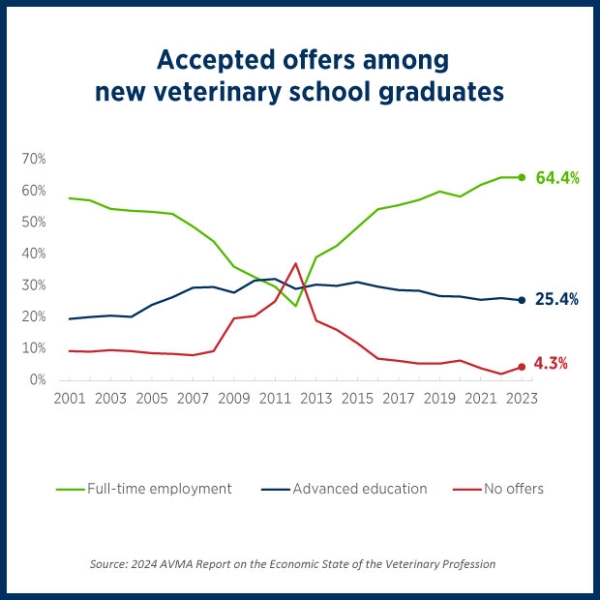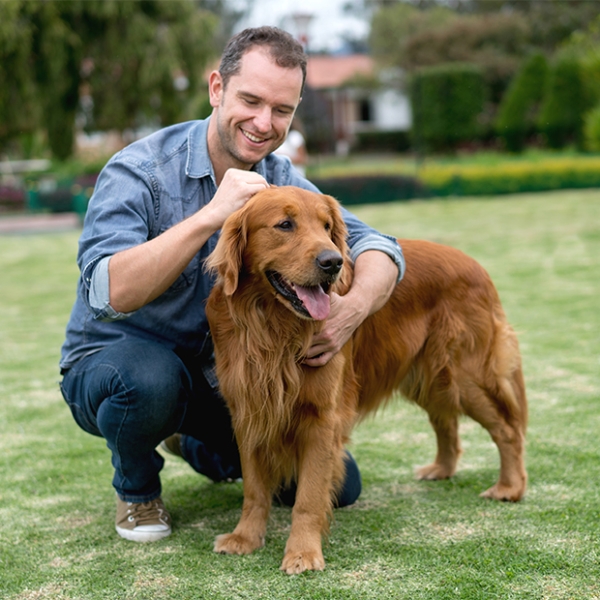Here’s one promising approach to address rural veterinary shortages
Rural veterinary shortages are real.
And the AVMA is working to help address them.
There are veterinarians who want to work in rural areas of America but are unable to do so—for financial reasons. The great news is that legislation pending in Congress would make it more feasible for them.
The bill, already boasting support from more than 100 stakeholder groups, is called the Rural Veterinary Workforce Act. If passed, this commonsense legislation would extend the reach of the popular Veterinary Medicine Loan Repayment Program (VMLRP) to help more food animal and public health veterinarians relocate to rural areas facing veterinary shortages. The best part: It would expand the available dollars for the program without additional funding.
What is VMLRP?
VMLRP helps veterinarians set up practice in locations designated as veterinary shortage areas by the U.S. Department of Agriculture (USDA). It does this by promising to pay off up to $75,000 of each veterinarian’s student loans if they practice in the shortage area for three years. Since the program’s inception in 2010, it has helped move 795 veterinarians into areas with veterinary shortages.
Unfortunately, there are still shortages. The need in rural America has outstripped VMLRP’s ability to respond—so far. The USDA currently recognizes veterinary shortages in a record-high 237 rural areas in 47 different states.
The bipartisan Rural Veterinary Workforce Act would go a long way to rectify the situation. Simply by treating VMLRP awards the same as equivalent awards made to physicians and other human health care providers, it would free up significant funds for new recipients. It could move more veterinarians into need areas without any additional budget being required.
That’s because the USDA is required to pay the federal tax on VMLRP awards on behalf of award recipients. All told, the department pays an additional 39% of each of the VMLRP’s annual awards just for taxes. The Rural Veterinary Workforce Act would end that requirement, making all of that funding available to bring additional veterinarians into the program.
Debunking other proposed “solutions”
There’s never been a more important time to attract more veterinarians to rural America. However, the lack of veterinarians in specific areas is also unfortunately fueling broad-reaching proposals for changes in how veterinary medicine is regulated and delivered—proposals that would put the health and safety of both animals and people at risk. Two proposals, in particular, are deeply concerning:
- There are calls for creation of a new midlevel position that could allow non-veterinarians to diagnose, prognose, make treatment recommendations, prescribe, or perform surgery.
- Multiple states are considering proposals to allow the VCPR to be established virtually, without an in-person examination or premises visit.
These proposals present grave risks to animal health and welfare, as well as public health, which AVMA President Dr. Rena Carlson has described here. They also carry special perils for rural America.
For example, introducing a midlevel position might further reduce the business sustainability of rural veterinary practices, worsening existing shortage situations rather than solving them. In fact, both the American Association of Bovine Practitioners and the American Association of Equine Practitioners join the AVMA in opposing creation of a midlevel position.
And while some proponents of a fully virtual VCPR argue that it would increase rural access to veterinary care via telehealth services, they overlook the reality that rural areas are more likely to lack the digital technology and broadband infrastructure needed to support telemedicine. Additionally, those animals that are not seeing a veterinarian regularly are also those more likely to have issues that require an in-person evaluation to resolve.
Rural veterinary workforce challenges are of particular concern in food animal production. While some have argued that adding more veterinarians to the profession’s pipeline will help ease these challenges, the reality is that about 75% of veterinary graduates become companion animal practitioners. Simply increasing the number of veterinarians entering the profession will not address the unique needs of rural, large-animal practitioners.
Support the Rural Veterinary Workforce Act
The Rural Veterinary Workforce Act, on the other hand, builds on a proven program that already has brought more veterinarians to rural America. If you recognize the need to attract more veterinarians to rural areas, please help support its passage. Send a letter asking your members of Congress to support this bill. Personalized letters from constituents have the greatest impact on Congress, so please personalize your letter with any stories you have about the importance of the VMLRP and the need to pass the Rural Veterinary Workforce Act.




Comments
Rural Veterinarians
Recruit students from rural background and lifestyle for Veterinary School. Focus more on Food Animal and change the present requirements for admission to Veterinary School to accommodate the this emphasis
rural vet students
Hi, I am amazed at the people that grew up with a rural/farm background that say that it showed and taught them that they DID NOT want to return to that life style. Teachers at Tennessee said that most of their students agreed and did not have a plan to return there. Heck no I do not have an answer. I agreed 100% with you till I was reeducated on the subject.
Lower standards? I am old (AU '79) but really every time there are large increases in the number of students admitted, the standards are lowered by default. Just like all professional schools. Do not get alarmed. I am not saying they will not be good professionals.
Just ask some older professors at older established schools.
VMLRP Awardee Longevity in Rural Communities
While I believe that the Rural Veterinary Workforce Act is promising legislation, and that the VMLRP program has many benefits, I am concerned at the lack of data available detailing awardee longevity in rural communities. The NIFA Internal Review document on their website states, "Assessing the long-term effectiveness of the VMLRP is an important but challenging goal for NIFA. Constrained by regulations governing the collection of information by federal agencies, VMLRP staff members have been unable to gather feedback from awardees beyond the completion of service." What do we know about the long-term impact of this investment of federal dollars? I hope the Rural Veterinary Workforce Act includes provisions which allow NIFA and USDA to gather better evidence and data in the area of rural veterinarian retention.
VMLRP and the Rural Veterinary Shortage
Although the VMLRP appears to be a well meaning attempt to reduce the shortage of veterinary service providers in rural America, I don't believe it will accomplish much, if anything especially if it is meant to increase services for animal agriculture. I'm a 1984 veterinary school graduate with a undergraduate degree in agricultural economics. During my first year in practice I recognized that the family farm was in deep trouble, many of the dairy and swine operations that we serviced were either in bankruptcy or getting closer each year. Larger, industrial operators handled routine problems on their own, used veterinarians solely as consultants or had in-house veterinary service providers. They used local veterinarians rarely or not at all. Today, the clinic where I once worked is now a small animal clinic and in the several counties we covered, the farms that use to have 100 to 250 head dairies and swine operators are now strictly grain farms. Do you really believe that a $25,000 a year subsidy for three years for a student that graduated with a $250,000 debt will solve the problem? I believe the barrier to rural animal medicine shortage lies much deeper in economics than veterinary student debt. And Dr. Garrett, I agree with you, what good does it do to graduate from veterinary school without the basic skills to perform surgery.
VMLRP - nice but won't solve problem as proposed
The Rural Veterinary Workforce Act is promising legislation and is part of the solution, but it won't solve the problem of veterinary shortages in rural communities by focusing only on the population of providers that has student loans. There needs to be incentives for experienced veterinarians to come back to rural areas, perhaps as second or third careers. The veterinarians who might be ready for a change of pace and need incentives and cash flow to start practices or buy practices in the rural areas as well as cover the salary gap that occurs by moving to a rural area.
These 2nd and 3rd career veterinarians have more clinical, life and business experience and acumen then the recent graduate. They may have spouses with their own careers and financial stability. They can bring this back to rural locations if incentivized.
We are mobile in our career progression. Don't let the Rural Veterinary Workforce Act focus only on a small segment of our population and limit what we as a profession could contribute.
VMLRP
As a rural resident who raises dairy goats, Great Pyrenees, and has a Clydesdale and a llama, I can vouch for the fact that finding reliable and affordable veterinary care for my animals is a gargantuan struggle. I am fortunate that I live a little less than an hour from NCSU Vet School, but even that doesn't help much in more emergent situations.
Debt relief and/or financial assistance in establishing rural practices is ESSENTIAL for expanding rural access to veterinary care for farm animals. We producers are out here, and we need the access in order to care properly and responsibly for our livestock. Helping the vets to have lower overhead due to lower debt can result in more affordable veterinary care for rural clients. We NEED this!
How to reduce Rural Vet Shortage?
Hi, I am giving a speech about the Rural Vet Shortage here in Oklahoma. So if anybody has anything that they would like to add for what they think would be a significant factor in declining the rural vet shortage I would greatly appreciate it
Add New Comment